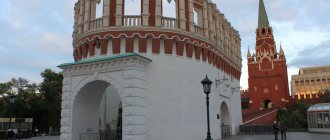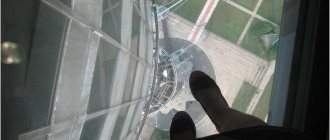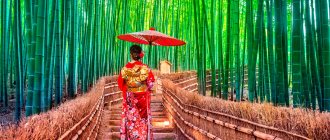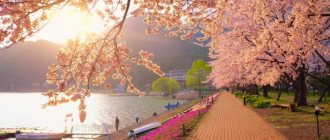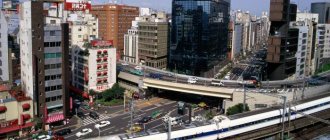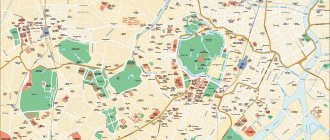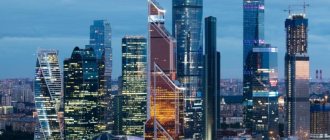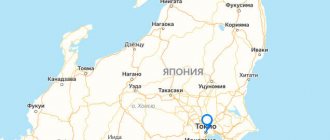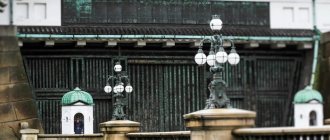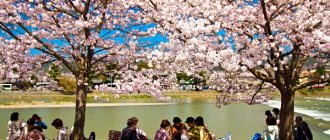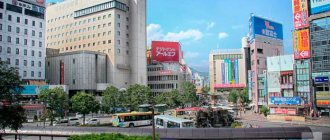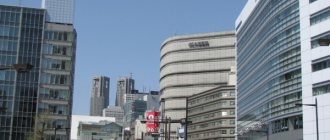Author:
Galina
15:30 | 11.01.2017
Heading:
Attractions
700
400
One of the most famous towers in the world stands in the capital of Japan. Residents are proud of this building, considering it the hallmark of the city. The Tokyo Tower took 18 months to build. Initially, they decided to build it for technical purposes. Television was rapidly conquering the world; several companies operated in Tokyo, broadcasting to the city and surrounding areas. At some point, the city authorities realized that television crews would build up the territory with antennas in order to increase the coverage area and attract new viewers. Spontaneous construction could damage the beauty of Tokyo. Under the influence of the authorities, the companies agreed to build one structure, the capabilities of which would be sufficient for everyone.
History of construction
The tower was built not only to have an analogue to a French landmark, but also to satisfy the need for public television and radio broadcasting. And so that the capital would not be oversaturated with the number of towers with antennas, the Japanese government decided to build only one, but a fairly powerful one. This is how the Tokyo Tower appeared (photo below).
It is worth noting that the height of the tower was originally planned to exceed the New York Empire State Building. But the goal was not achieved simply due to lack of funds. Therefore, it was decided that the height should simply be the maximum possible for high-quality television and radio broadcasting within a radius of up to one hundred and fifty kilometers.
The design of the tower was developed by the engineering company Nikken Sekkei and chief architect Tachu Naito. Thanks to them, the television and radio tower turned out to be resistant to serious earthquakes and typhoons. The tower was erected through the efforts of several hundred Japanese builders.
The grand opening of the Tokyo Tower took place in December 1958.
Tokyo TV Tower Project
The chief engineer had several key tasks:
- designing the tallest building in the country;
- earthquake resistance, since Japan often faces the most devastating vibrations of the earth's crust;
- creating a structure that can withstand typhoons and hurricanes.
Naito analyzed his own experience, all European skyscraper projects and took the French Eiffel Tower as the basis for his plan. That’s why any tourist can so easily recognize the familiar contours of a popular Paris landmark in the TV tower.
Characteristics and interesting facts
Tokyo Tower:
- Height - three hundred thirty-three meters.
- Weight - four thousand tons.
- Lighting - one hundred and sixty-four spotlights.
- Color – twenty-eight thousand liters of white and orange paint.
- The material used to build the tower is high-strength steel, some of which is melted down American tanks.
Interesting Facts:
- Every five years, the Tokyo Tower undergoes restoration and repainting.
- Until 1987, illumination was much more modest. The management decided to modernize the lighting system in order to attract more tourists.
- At different times of the year, the tower is illuminated in different ways: from July to October - white, from October to July - orange. Color may vary for some holidays, events and occasions. For example, during the premiere of the film "The Matrix" the tower was illuminated in green, as it was for the fiftieth anniversary of Japanese-Irish relations, and annually in National Breast Cancer Prevention Month (October 1) - pink.
- To convey some images on the tower during promotions, the windows of the observation deck (observatory) are used.
- Despite the fact that the Tokyo Television Tower was built more than half a century ago, it is still considered a modern landmark.
- The colors for painting the tower were chosen to ensure aviation safety.
History of Tokyo Tower
In 1953, public broadcaster NHK began its first television broadcasts in the Kanto region. Japan at the time was experiencing a construction boom driven by rapid economic growth. Everyone needed a television tower: small private companies, NHK, the authorities. The project was led by Hisakichi Maeda, founder and director of Nippon Denpatō.
Initially it was planned to build the tallest structure in the world. However, due to the lack of necessary funds, we settled on the current project. The height of the tower is 332.6 meters. Manufacturing material – steel. It ranks 23rd on the list of the 29 tallest television towers. Construction began in June 1957 and lasted 18 months. Interestingly, some of the steel for the structures was obtained by melting down old American tanks that were damaged and left on the battlefields.
According to Japanese sources, 220,000 workers were involved in construction at a time (maximum). 30 million US dollars were invested in the project. The chief architect, Tachyu Naito, took the design of the Eiffel Tower as a basis. Thanks to more modern technologies, Tokyo Tower turned out to be much lighter. Its structure weighs 4 thousand tons, which is 3.3 thousand tons less than the calling card of Paris.
The television tower hid behind trees and houses
Purpose of Tokyo Tower
Tokyo Television Tower (Japan) is a huge tourist and entertainment complex, within the walls of which are concentrated:
- tourist area;
- TV and radio broadcasting zone;
- observation decks.
At all levels there are small cafes and buffets, places to relax, and shelves with booklets. And in souvenir shops you can buy both tower figures of different sizes and compositions (plastic, glass, iron), as well as items depicting a television tower (for example, T-shirts, paintings and posters, cups and other utensils, magnets, key rings, etc.).
TV Tower (Tokyo, Japan): Brief Description
Even on a fleeting visit to Tokyo, it is difficult to ignore this unusual tower. It stands out against the background of glass and concrete skyscrapers of the metropolis with its cheerful white and orange color, and its design surprisingly resembles the famous Eiffel Tower. However, the Japanese proudly say that the Tokyo Television Tower, whose height is three hundred thirty-two meters, is much lighter than its prototype and can withstand earthquakes and hurricanes. And indeed it is. The supporting structures are designed in such a way that they can allow the tower to deflect up to eighty meters in both directions in heavy winds. At the same time, such vibrations will not cause any harm to the supports.
For nine years after its construction, the Tokyo Television Tower was the tallest in the world, and now it ranks only fourteenth on this list. There are currently two towers in Tokyo: one has become a tourist attraction, and the second, more than six hundred meters high, is operational and broadcasts in the metropolis and its suburbs.
Tourist area
The tourist area is the first four floors of the television tower, on which there are:
- First floor: main entrance, an aquarium with more than eight hundred species of fish, a large restaurant that can accommodate up to four hundred people, three elevators.
- Second floor: various shops and restaurants.
- Third floor: wax museums and Guinness Book of Records, holographic exhibition.
- Fourth floor: a free exhibition of achievements in the field of electronics and communications technology from Terso, a famous exhibition of optical illusions, and there is also a museum with the history of the Tokyo TV tower (various photographic facts, terrain models, historical references, and so on are presented here).
- Rooftop: There is a park with a small number of simple children's attractions.
Also in the tourist area you can meet two mascots of the tower - humanoids in blue and red overalls. Their height is two meters twenty-three centimeters.
The total number of stores on the territory of the television tower exceeds several hundred.
Famous Tokyo Tower, Japan
Located in Shiba Park, the 333-meter tall Tokyo Tower was considered the tallest steel structure in the world when it was built in 1958. The original purpose of the Tokyo Tower was to broadcast television to Tokyo and the Kanto region, but three years later radio antennas were additionally installed on it, making it possible to transmit radio signals. According to aviation safety standards, Tokyo Tower is painted white and orange.
The Tokyo Tower antennas were used to transmit television and radio signals from major Japanese television networks such as Fuji Television, NHK and TBS until 2011, when a new tower was erected, significantly higher than Tokyo Tower and designed to broadcast a digital signal. Today, Tokyo Tower is one of the symbols of Tokyo, a tourist attraction, whose observation decks are visited every year by about 2.5 million tourists from all over the world. So I decided to be one of them, and for this I went to the TV tower.
Tokyo Tower is very similar in design to the Eiffel Tower in Paris . In addition, at the entrance all tourists are given reminders, from which I learned that the tower in Tokyo weighs 3 thousand tons less than the Eiffel Tower, but it is several meters higher than the Parisian one. Beneath Tokyo Tower is a four-story building that includes a variety of museums, souvenir shops, and restaurants. The Tokyo Tower has two observation decks at different heights.
Currently, Tokyo Tower is a unique museum and tourist complex. On the ground floor there is a large aquarium , which is considered one of the best in Japan - it is home to about 800 different species of fish. Entrance to the aquarium, if I'm not mistaken, costs 1000 yen.
Above is the Wax Museum , the exhibition of which is so rich and interesting that it can rival, for example, Madame Tussauds in London. There is also a permanent exhibition of holography DeLux, and to enter this floor you need to pay 850 yen separately. On the roof of the building under Tokyo Tower there is a not very large amusement park with simple children's attractions.
We go up in the elevator, where young female employees in kind and slightly squeaky voices divide the entire queue and show each of the visitors his place. On the way back in the elevator, I was riding with a pretty Japanese girl, I folded my hands and so did she, I look at her and she looks at me. I think it was love).
As I already mentioned, there are two observation decks in Tokyo Tower . The lower platform is at an altitude of 150 meters, and the upper one is at an altitude of 300 meters. It is much more difficult to get to the upper observation deck, because you need to climb from the lower one, plus you have to wait in line for about an hour. Among other things, you need to purchase an additional ticket to get to the upper observation deck.
On the lower observation deck of the Tokyo Tower there is a special board where you can see how long you will have to wait for your turn.
This is the view from the lower platform of Tokyo Tower. Near the temple, located in the same park as the tower, there is a cemetery, and even more than one!
From Tokyo Tower you can see the Rainbow Bridge , which I also advise everyone to take a walk to.
By the way, both observation platforms of the Tokyo Tower are equipped with telescopes , with the help of which you can see this or that part of Tokyo up close. And on a clear day, the cone of the majestic Fuji volcano is visible from the platforms.
I have only positive impressions of Tokyo Tower. I think this is a great location with good views of Tokyo. In addition, the TV tower stands out among the gray buildings of Tokyo, built very close to each other. At night, Tokyo Tower, illuminated by thousands of lights, becomes even more attractive!
TV and radio broadcasting area
On the floors closed to tourists and visitors are located:
- television and radio studios;
- antennas for eight television stations;
- television cameras that monitor the capital's main highways;
- scientific equipment (for example, seismographs, anemometers, etc.).
With the transition of Japanese television to a digital format in 2011, part of the broadcasting was transferred to the new Sky Tree tower, since the height of the old one did not allow high-quality broadcasting of channels, and the height of the new one was six hundred thirty-four meters. And the antennas of those stations that remained had to be increased by twenty meters - from eighty to one hundred.
Observation platforms (observatories)
There are only two observation platforms:
- at an altitude of one hundred and fifty meters: lower observation deck;
- at an altitude of two hundred and fifty meters: the upper observation deck.
The lower one is two-story. On the first tier there is a stage for live musical performances, a club and a small cafe. There are also two areas with an observation window in the floor. On the second tier there are points for selling souvenirs and a Shinto shrine. The total area of the lower observation deck is one hundred and forty-seven square meters.
The upper platform is completely glazed. Both sites are equipped with special terminals; on their display you can take a closer look at each building and learn more interesting details about it (for example, height, what is inside, and so on). Also on the monitor you can watch a video about how the city has changed over the past 24 hours and a satellite map.
Both the lower and upper observatories offer panoramic views of the capital, and on a clear day you can still see Mount Fuji and Tokyo Bay.
Tourist significance of Tokyo Tower
According to statistics, more than 150 million people have visited the tower since its opening. At its base there is a “Podnozhny town”, consisting of museums, cafes, recreation areas, shops and the like. It occupies a huge, four-story building. By the way, Tokyo Tower descends 20 meters underground. There are technical structures located there that ensure the stability of the tower.
The first floor of the Podnozhny town is an aquarium in which more than 50 thousand varieties of marine life are exhibited. There is also a banquet hall and many souvenir shops. On the upper floors, tourists are attracted by other attractions. In particular, on the third one you can explore the Guinness Book of Records museum and admire the wax figures.
There are children's attractions and a small park on the roof of the Podnozhny town building. You can get here without an elevator; you have to climb 590 steps. Tokyo Tower attracts tourists with its observation decks. The first one is 150 m and has two floors. Part of its floor is transparent, so visitors can view the ground below their feet and to the horizon. From here in good weather you can see Mount Fuji.
On this level there is a hall used for musical performances and the tallest Shinto shrine in Japan. This establishment is operational. The upper observation deck - 250 m - is a completely glazed room.
How to get there?
TV tower address: 4, Shibakoen, Minato, Tokyo 105-0011.
Tokyo Tower (Japan) is located near Onarimon and Akabanebashi subway stations. The first is located on the Mita metro line, the second - Oedo.
You can also get there from the Yamanote-Hamamatsu Railway Station. The tower is a fifteen minute walk from the stop.
How to find the TV tower?
In Tokyo, the tower can be seen from almost anywhere, and organized groups of tourists almost constantly come here to climb the observation decks. But if you decide to take an excursion to this attraction on your own, then you need to know the address where the television tower is located: Tokyo, Minato, Shiba-koen, 4-2-8.
The easiest way to get here is by metro. Almost all underground stations in Japan have information boards indicating attractions and the stations closest to them. This scheme will help you easily cover the distance and enjoy the views of Tokyo from either of the two observation decks.
Opening hours and fees
The tower's opening hours for visitors are from 9:00 to 23:00, but you can enter until 22:30. You can get to the TV tower any day.
Rates:
- 900 yen (7 dollars, 380 rubles) – visit only to the main observatory (observation deck);
- 1600 yen (12 dollars, 675 rubles) – visit to two observation platforms.
Tickets can be purchased at one of the ticket offices located at the entrance on the ground floor. Waiting time in line rarely exceeds ten to fifteen minutes.
To date, the number of people who have visited Tokyo Tower in its entire history exceeds one hundred and fifty million. During this time, a belief even appeared that if lovers admire the tower at the moment when the night illumination turns off (at exactly midnight), they will live happily ever after.
TV tower today
Tokyo Tower has long been the main symbol of the city. It is depicted on postcards, travel brochures and is often used in various feature films as an image of Tokyo. Tourists note that in reality the tower impressed them even more than in the descriptions on various websites. You can explore this building all day and get a lot of completely different impressions. Interestingly, depending on the events held in the city, the illumination of the tower can change its hue. For example, ten years ago, in honor of Japanese-Irish relations, the color of the floodlights changed to green. And on Valentine's Day, hearts appear on Tokyo Tower. Tourists who were lucky enough to see this spectacle claim that they have never seen anything more incredible.
Tokyo is the noisiest city in Japan, it is always bustling with life, and the number of attractions makes it extremely attractive to tourists from all over the world. For many years, Tokyo Tower has held the palm among the most visited places in the city. Therefore, if you dream of traveling to Japan, then start it with Tokyo.
